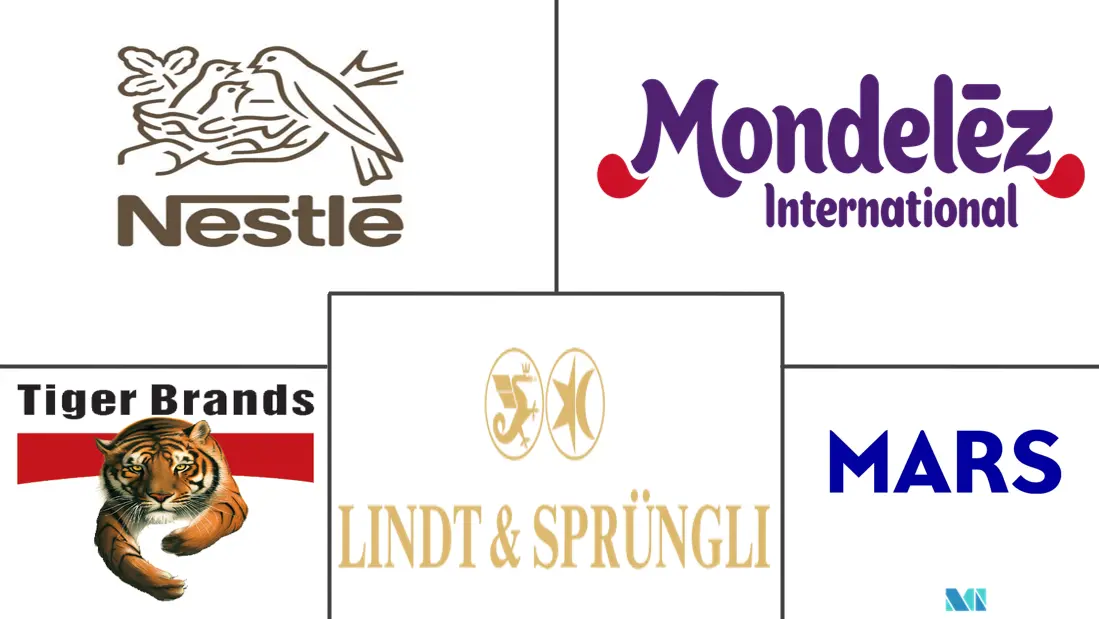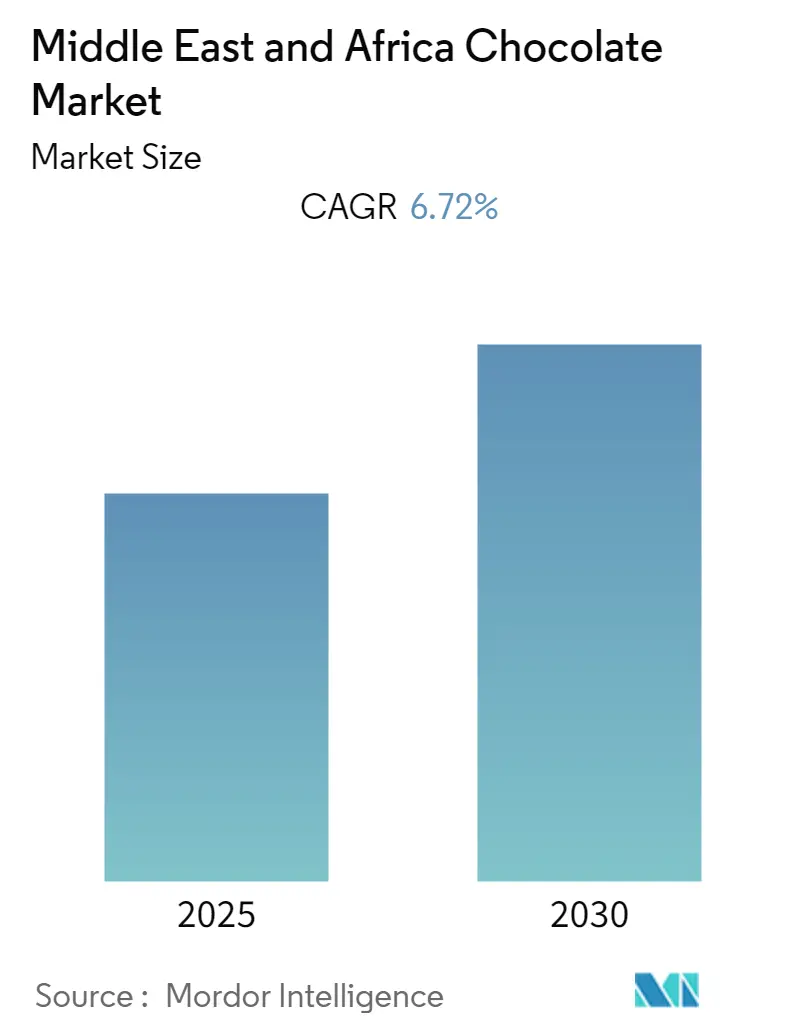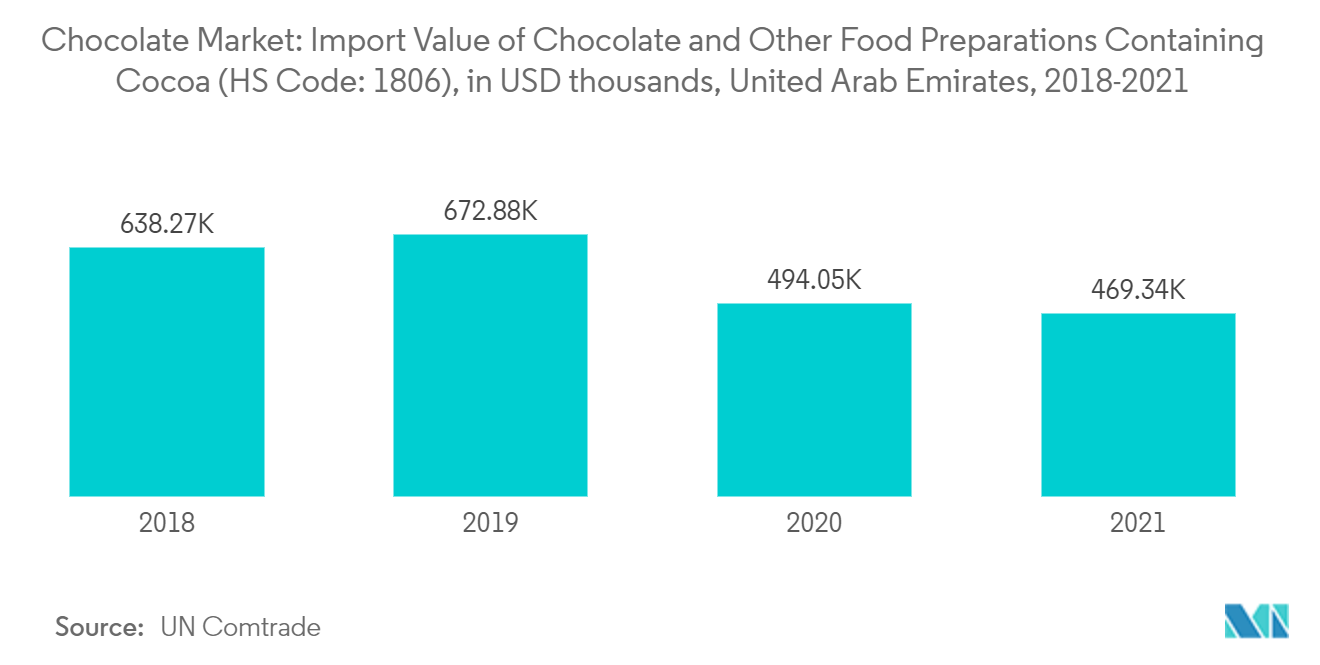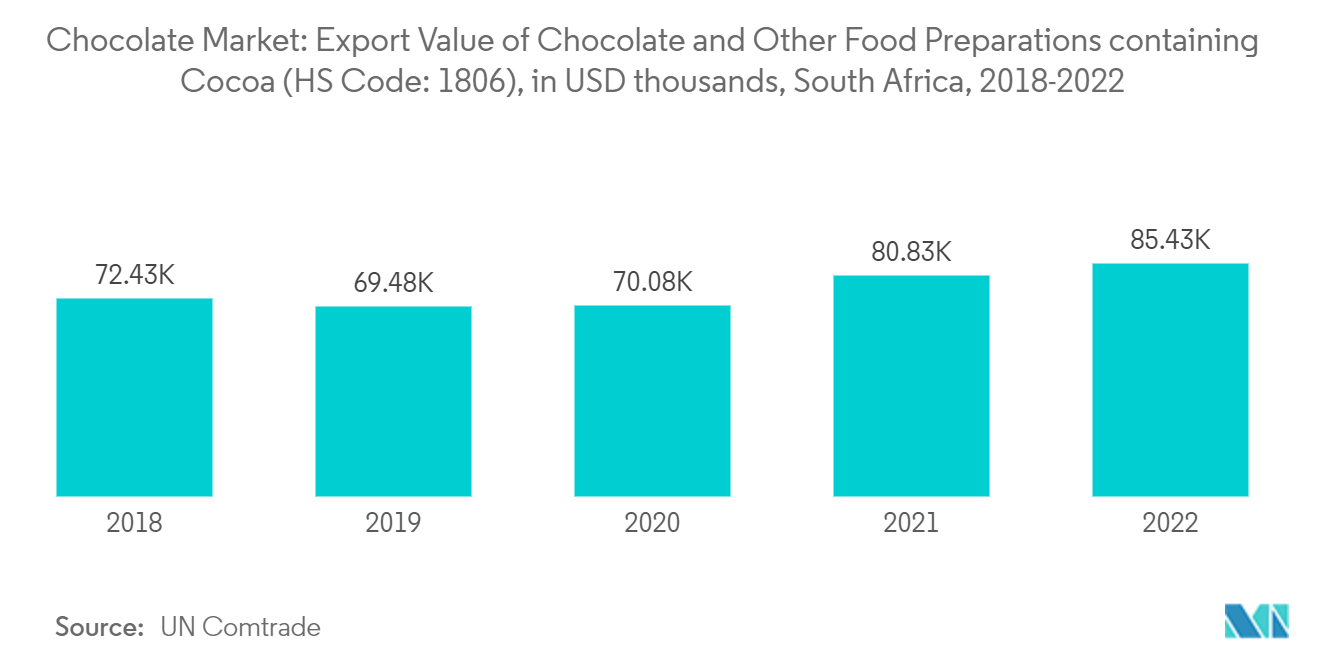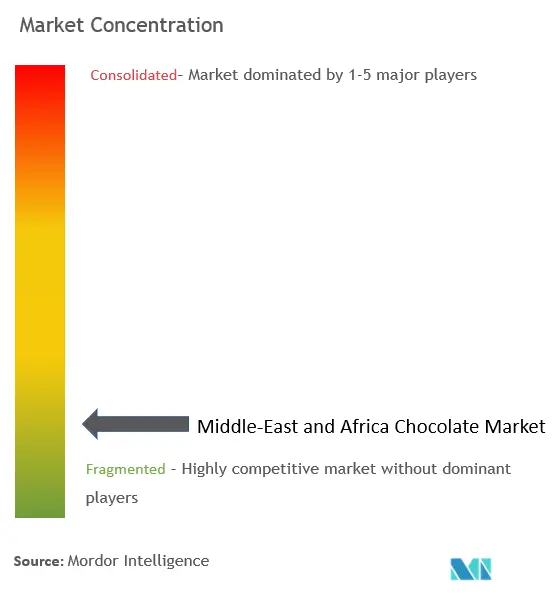MEA Chocolate Market Analysis
The Middle East and Africa Chocolate Market is expected to register a CAGR of 6.72% during the forecast period.
Chocolate and chocolate-based products make most of their sales in the region through convenience stores and specialty outlets. The United Arab Emirates and most Middle Eastern countries rely on imports from major foreign brands, such as Barry Callebaut, Ferrero, and Lindt, rather than domestic production. Development in modern retailing also boosted the demand for chocolate in the Middle East. Furthermore, the large expatriate population in the Middle East and African countries, such as United Arab Emirates, Saudi Arabia, and Nigeria, contribute to the increasing demand for chocolates in the region. For this reason, imported chocolates have a huge opportunity in this region, as a proper distribution network can help improve the addressable market in the Middle Eastern nations.
Growing demand for artisanal chocolates is driving demand in this region, with several companies starting their establishments and using them to promote their brand. With the trend moving toward quality, the inherent flavor of cocoa beans is given a particular emphasis. The products in this segment are prepared using fresh cocoa beans and carved into chocolates by small-scale chocolatiers. The premium cocoa market, with sustainability certification and single-origin, accelerates the market's overall growth. This development is driven by the health trend and the quest for more exclusive products. Consumers place greater emphasis on the quality of chocolates, owing to increasing health concerns involving cheaper chocolates in the region and a surge in the popularity of fine cocoa. Therefore, consumers are willing to pay more for chocolate products that meet their demands.
MEA Chocolate Market Trends
Countlines and Premium Dark Chocolates Hold a Major Market Share
Countline chocolates are most popular among teenagers and consumers under 25 years of age, owing to their convenience factors as they are designed to be eaten as a snack and on the go. The rise in consumption of countline chocolates in the United Arab Emirate region has stimulated market growth, as the United Arab Emirates is emerging as one of the most potential markets for chocolates, due to the increase in the number of international chocolate companies, along with the domestic players, coupled with changing snacking preferences of customers. It also includes products sold in diverse formats, such as 'multipacks' or 'mini-fun' sizes. The convenient sustainable packaging with attractive offers also drives the chocolate market during the forecast period.
Dark chocolate has strong antioxidants found in them. One of the best flavonols is called epicatechin. Plants have compounds called flavonols that lessen inflammation and protect against cell damage brought on by free radicals. Higher cocoa content chocolate contains more beneficial flavonols. Most of the benefits noted by numerous research are related to chocolate with at least 70% cacao. Also, For instance, a study that appeared in the journal Appetite found that people who consumed chocolate, particularly dark chocolate, at least once a week had a lower prevalence of diabetes and were less likely to get the disease four to five years later. People who consumed dark chocolate less than once per week had a two times higher chance of developing diabetes than those who consumed it more frequently, according to the research of 908 non-diabetic adults and 45 people with diabetes. Due to these benefits, consumers are gravitating toward products that claim to be made with dark chocolate. Therefore, these factors drive the market in this region.
South Africa is the Fastest-Growing Country
South Africa is registering fast growth, contributing to the overall sales of the chocolate market in the Middle East and Africa. For instance, in 2021, according to IFIC (International Food Information Council), the annual cocoa production in Africa accounted for approximately 4,400 million metric tons. The majority of the sales growth in the chocolate market in South Africa is attributed to the mass merchandisers, such as hypermarkets and supermarkets. The rising consumer awareness and increasing disposable incomes among middle-income consumers, product innovation, as well as channel development by manufacturers to reach a wider consumer base are some of the major factors that are expected to boost the sales of the chocolate market in South Africa, during the forecast period. Hence, due to rising consumer spending power and escalating marketing and promotional efforts, there has been an increase in demand for premium chocolates. Also, because of the growing tendency of giving gifts, boxed assortment sales are increasing more quickly. Moreover, premium ranges are combined with other ingredients, such as almonds, raspberry chunks, or alcohol, and their packaging describes a more sophisticated feel. The supermarkets/hypermarkets offer discounts on heavy-priced premium chocolate products, which is expected to boost sales even further. Therefore, all the above mentioned factors drive the Middle East & Africa Chocolate Market.
MEA Chocolate Industry Overview
The Middle-East and African Chocolate Market is highly fragmented, with various companies from around the world holding market share in the region. The Middle East and African chocolate market is highly competitive, with a significant presence of both global and regional players. Prominent players in the market studied are keen on building an appetite for higher-priced chocolates among young consumers by increasing accessibility and launching innovative products. Companies also focus on expanding their distribution channels to reach out to a larger consumer base. New product innovations, partnerships, mergers and acquisitions, and expansions are the major strategic approaches preferred by the companies in the market studied. Mars Incorporated, Lindt & Sprungli AG, and Nestle are the most active companies in the Middle East & Africa chocolate market. Over the last few years, expanding market presence in emerging economies and product innovations have been a key growth strategy for major companies.
MEA Chocolate Market Leaders
-
Nestle S.A.
-
Mondelez International Inc.
-
Tiger Brands Limited
-
Chocoladefabriken Lindt & Sprüngli AG
-
Mars Incorporated
- *Disclaimer: Major Players sorted in no particular order
MEA Chocolate Market News
- In March 2022, Barry Callebaut launched its line of whole-fruit chocolates under the Cacao Barry brand in the United Arab Emirates. The product has 40% less sugar than conventional dark chocolate and is made from 100% pure cacao fruit. The company partnered with Cabosse Naturals, who work closely with local cacao fruit farmers in Ecuador, to source the upcycled cacao fruit pulp and peels for the product.
- In February 2022, Made By Two, a Dubai-based artisanal chocolate boutique, launched its collection of glazed luxury chocolates. The product line is influenced by art, form, and design, and it has novel flavors, vibrant colors, and intricate craftsmanship.
- In October 2021, Barry Callebaut opened a new Chocolate Academy at the foot of Burj Khalifa in Dubai, United Arab Emirates. The new location and facility will serve as a creative platform for chefs and artisans to display and develop their abilities and talents. The company has 24 such establishments across the world. This move aims to propel innovation as there is a shift in consumer preference towards premium products and new varieties in the chocolate market.
MEA Chocolate Industry Segmentation
Chocolate is a liquid, solid, or paste formed from roasted and powdered cacao beans that can be consumed on its own or used as a flavoring ingredient in other meals. The Middle East and Africa Chocolate Markets is segmented by Type, Product, Distribution Channel, and Geography. Based on type, the market is segmented into Dark Chocolate, and Milk/White Chocolate. By Product, the market is segmented into Softlines/Selflines, Boxed Assortments, Countlines, Seasonal Chocolates, Molded Chocolates, and Other Product Types. Based on Distribution Channel, the market is segmented into Supermarkets/Hypermarkets, Specialty Retailers, Convenience/Grocery Stores, Online Retail Stores, and Other Distribution Channels. Based on Geography, the report includes South Africa, Saudi Arabia, the United Arab Emirates, and the Rest of the Middle East and Africa. For each segment, the market sizing and forecast have been done based on value (in USD million).
| Product | Dark Chocolate |
| Milk/ White Chocolate | |
| Type | Softlines/Selflines |
| Boxed Assortments | |
| Countlines | |
| Seasonal Chocolates | |
| Molded Chocolates | |
| Other Product Types | |
| Distribution Channel | Supermarkets/ Hypermarkets |
| Specialty Stores | |
| Convenience/Grocery Stores | |
| Online Retail Stores | |
| Other Distribution Channels | |
| Geography | South Africa |
| Saudi Arabia | |
| United Arab Emirates | |
| Rest of Middle-East and Africa |
MEA Chocolate Market Research FAQs
What is the current Middle East and Africa Chocolate Market size?
The Middle East and Africa Chocolate Market is projected to register a CAGR of 6.72% during the forecast period (2025-2030)
Who are the key players in Middle East and Africa Chocolate Market?
Nestle S.A., Mondelez International Inc., Tiger Brands Limited, Chocoladefabriken Lindt & Sprüngli AG and Mars Incorporated are the major companies operating in the Middle East and Africa Chocolate Market.
What years does this Middle East and Africa Chocolate Market cover?
The report covers the Middle East and Africa Chocolate Market historical market size for years: 2019, 2020, 2021, 2022, 2023 and 2024. The report also forecasts the Middle East and Africa Chocolate Market size for years: 2025, 2026, 2027, 2028, 2029 and 2030.
Our Best Selling Reports
Chocolate in MEA Industry Report
Statistics for the 2025 Middle East and Africa Chocolate market share, size and revenue growth rate, created by Mordor Intelligence™ Industry Reports. Middle East and Africa Chocolate analysis includes a market forecast outlook for 2025 to 2030 and historical overview. Get a sample of this industry analysis as a free report PDF download.

